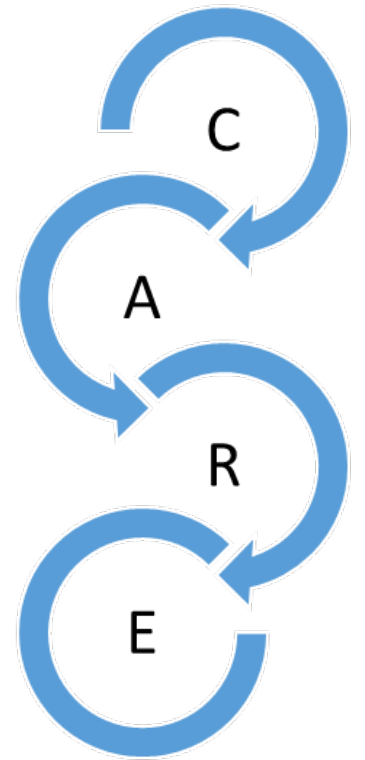A Coaching Model Created by Andrea Bruns
(Life Coach & Career Coach, GERMANY)

My C.A.R.E. coaching model is a four-stage framework that helps me to have a structured approach in my coaching sessions. It also allows me to keep my coaching style flexible and client-focused at all times. It is important that the coach guides only the process by asking open-ended, non-leading questions and the client always needs to hold the agenda and drive the content. The coach must be entirely nonjudgmental in every stage. In comparison to other coaching models like the GROW Model, my coaching model arises with an earlier stage. It indicates the importance of creating a relationship between the coach and the client. Each coaching relationship needs to be client-designed to meet the particular needs of the client. Therefore, the first phase in my coaching module is called “Creating Relationship”. Every client is different and wants to be coached in a different way, has different values and perceptions. By discovering this at an early stage the coach is able to focus from the very beginning on the whole person and how to best support the client. This is the foundation to create a good relationship where trust, openness and a safe space are established for the client. Through a good relationship, the best possible outcome for the client can be achieved.
Creating a Relationship:
The client is the focus and center of everything in coaching. The power of coaching resides in the relationship between coach and client. It is important that the client feels safe and supported in the coaching session. Here are some aspects for creating a relationship between coach and client to best support and empower him or her.
After confirming confidentiality it is very important that coach and client discuss strategies for working together and what will make the relationship as effective as possible for the client.
The Coach can ask the following questions:
Also the coach should ask for permission to challenge the client and hold him or her accountable.
Creating a good relationship also involves discovering the necessary background and other personal information that will be useful during the coaching.
The coach may ask the following questions:
In this stage, where the foundation is set and trust is established it is also advisable to help the client to identify his or her values. When the client is aware of his values it can help him through the whole coaching progress. It can support him to understand obstacles that are preventing or limiting progress or guide him to make decisions aligned with his own values. To make a decision based on the clients top values will always be a fulfilling one.
Possible questions to help the client to identify his values could be:
By clustering and measuring the client’s values he or she can be self-aware of what is stopping him or her from honoring certain values and what would it take to honor them more.
There are many exercises and visualizations that can also help identifying the client’s values.
Assessing the Goal:
The second stage of my coaching model is to identify and clarify the goal the client wants to achieve. It is extremely important that the coach listens carefully to the client’s words, asking the right questions and challenge the client to go deeper. That helps the client to identify what they truly want to accomplish.
Questions to define the goal can be:
Raising Awareness/Exploration:
In this third stage the coach supports the client to become aware of the current situation, to determine how far he or she is away from his or her goal and explore with the client the options for reaching his goal. The coach needs to consider that there might be an underlying belief like „I am not good enough“, or „I am stupid“ etc., that might be an obstacle. In this case the coach should help the client to be aware and must support him or her to detect and name the underlying belief. By detecting and naming it, it is possible for the client to reveal any underlying beliefs that may drive his or her behaviour.
Questions regarding the exploration of the current situation could be:
After exploring the current situation, the client can explore the options for reaching the goal:
Questions for exploring options:
Ensuring Commitment/Action:
The last stage of the model is to generate commitment. The client needs to formulate from his thoughts a plan of action to achieve his or her goal. The action plan should be detailed, showing specific action steps and when each step has to be done. The coach’s support is to ask the client certain questions to hold him accountable?
It is useful to ask the following questions:
<<Find out more about how to create your own Coaching model at ICA>>